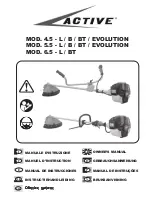
23
2
Blade and Material Combination
The appropriate blade differs depending on the material type and thickness. Before cutting the material, be sure
to perform test cut (trial cut). For details on trial cutting, see “Test Cut (Trial Cut)” on page 25.
Use the following table to select the appropriate cutting blade according to the material that will be cut.
Material compability may vary. Always perform a test/trial cut to confirm a successful cut.
If you need additional help, the Brother Solutions Center offers the latest FAQs and troubleshooting tips.
Visit us at “ http://s.brother/cpoac/ ”.
• Use a high tack adhesive fabric support sheet or a iron-on fabric appliqué contact sheet when you cut a piece of
fabric out. For details, see “Reference Table of Mat and Material Combinations” on page 14.
• Depending on the model, the thin fabric auto blade may not be included. In that case, it can be purchased as an
optional accessory.
Note
•
An auto blade holder is included with this machine. With this blade holder, the thickness of the material is
detected, and the blade extension is automatically adjusted.
•
Thick or hard material will automatically be cut multiple times.
Material
Thickness
Auto blade holder
Auto Blade (Black)
Thin Fabric Auto Blade
(Beige)
Pap
e
r
Printer paper
80 g/m² (0.1 mm)
Scrapbook paper
200 g/m²
(0.25 mm)
Cardstock
280 g/m²
(0.35 mm)
Vellum, tracing paper
0.07 mm
Poster board
400 g/m²
(0.5 mm)
Fa
b
ric
Thin cotton fabric (for quilt piece)
0.25 mm
Thin cotton fabric (except for quilt
piece)
0.25 mm
Flannel (for quilt piece)
0.5 mm
Flannel (except for quilt piece)
0.5 mm
Felt
3 mm
Denim 14 oz
0.75 mm
Ot
h
e
rs
Plastic sheet (PP)
0.2 mm
Vinyl
0.2 mm
Adhesive Craft Vinyl (backing sheet
: 0.1 mm)
0.07 mm
Magnet
0.3 mm
Sticker or seal
0.2 mm
Sticker Sheet (backing sheet :
0.15 mm)
0.15 mm
Foam sheet
3 mm
















































